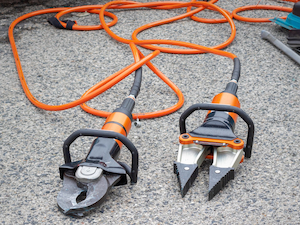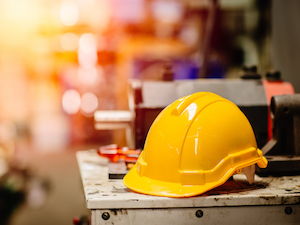Hydraulic tools are essential across a range of industries. They lift, push, bend, and cut with power that far exceeds manual tools. But behind that power lies a system operating under extreme pressure and when things go wrong, the results can be devastating.

Hydraulic tools can be either manual, using a hand or foot pump, or hose-connected to an external power source for higher force and speed. Manual hydraulic tools are portable but slower, while hose-connected hydraulic tools are suited for heavy-duty or repetitive tasks. Hydraulic tools can perform heavy-duty work with high precision and minimal effort from the user.
Whether you’re using a hand-operated jack or a hose-powered cutter, understanding how these tools work and how they can fail is critical to protecting yourself and others on the job. And yet, many workers underestimate the risks until it’s too late.
How Hydraulic Tools Work
Hydraulic tools run on pressurized fluid, which moves through hoses and valves to generate controlled force. It sounds simple, but the pressures involved can be staggering, often reaching several thousand pounds per square inch. If a hose bursts, or a fitting fails, that fluid is released with dangerous speed.
OSHA Standard 1926.302(d)(2) The manufacturer's safe operating pressures for hoses, valves, pipes, filters, and other fittings shall not be exceeded.

Leaks or bursts can release fluid at such high pressure that it can penetrate the skin or eyes. Injuries from hydraulic fluid aren’t always obvious at first. A pinhole leak can inject oil into the skin like a syringe, causing internal damage long before anyone realizes something is wrong. These injuries require emergency medical attention, not just first aid. Time matters.
Inspection and Maintenance
Good hydraulic safety begins long before the tool is activated. Workers should inspect every hose, fitting, and component before use. Look for cracks, kinks, bulges, and signs of wear. Ensure couplings are tight and leak-free. Confirm all guards are in place and the tool is suited for the job. Ensure that you’re using the correct fluid which should be clean, filtered, and uncontaminated.
OSHA Standard 1926.302(d)(1) The fluid used in hydraulic powered tools shall be fire-resistant fluids approved under Schedule 30 of the U.S. Bureau of Mines, Department of the Interior, and shall retain its operating characteristics at the most extreme temperatures to which it will be exposed.
It’s also important to store tools properly. Dirt, moisture, and heat can degrade hoses and seals, weakening them over time. Keep equipment dry, clean, and out of harm’s way. Simple habits like capping unused ports or avoiding sharp bends in hose storage go a long way in extending tool life and preventing surprise failures.

Routine maintenance for hydraulic tools isn’t optional, it’s required. Replace worn hoses and fittings right away. Keep fluid clean. Protect hoses from heat, crushing, or sharp edges. And always follow the manufacturer’s guidelines for inspection and servicing.
PPE for Hydraulic Tools
Using the right personal protective equipment (PPE) can prevent serious injuries. At a minimum, this includes eye and face protection for high-pressure spray and flying debris and cut-resistant gloves to protect your hands. Steel-toe boots are beneficial for impact protection and long sleeves and pants help to guard against fluid splashes.
OSHA Standard 1910.133(a)(1) The employer shall ensure that each affected employee uses appropriate eye or face protection when exposed to eye or face hazards.
Hydraulic System Failure
Mechanical failure is a danger when using hydraulic tools. Worn or damaged components can suddenly shift, fall, or break apart under load. A poorly secured hose, a cracked fitting, or a bent tool arm might hold steady for hours, until it doesn’t.
Some of the most serious incidents with hydraulic tools happen not during operation, but while tools are being connected or disconnected. Workers assume it’s safe once the power is off. But hydraulic systems often retain stored energy even after the pump shuts down. Releasing pressure before loosening connections isn’t just a recommendation, it’s a rule that protects fingers, faces, and lives.
Hydraulic Tool Hazards
Slips, trips, and entanglement hazards are common when working with hydraulic tools. Hydraulic hoses rarely stay in one place for long. They get moved, kicked, tangled, and run across walkways. A loop of hose on the ground might look harmless until someone’s foot catches it.

Hydraulic fluid leaks, even small ones, make walking and working areas slick and unpredictable, causing slip and fall hazards.
OSHA Standard 1910.22(a)(3) Walking-working surfaces are maintained free of hazards such as sharp or protruding objects, loose boards, corrosion, leaks, spills, snow, and ice.
Depending on the type of hydraulic tool you are using, there might be pinching and crushing hazards. If your hands or feet are in the wrong place, the powerful motion of hydraulic tools can crush or trap them in an instant.
Hydraulic Tool Training
Hydraulic tools aren’t intuitive. They look simple on the outside, but what’s happening inside is complex, high-pressure mechanics. That’s why only trained workers should operate or maintain them. Understanding the manufacturer’s instructions, and the limits of the tool, is part of using it safely.
Too often, shortcuts are made in the name of speed. A safety valve gets bypassed. A guard gets removed. A hose gets swapped with the wrong type. Each of these decisions increases the risk of catastrophic failure. And in many cases, the injury that results doesn’t just affect the person holding the tool, it affects everyone nearby.

.jpg)

